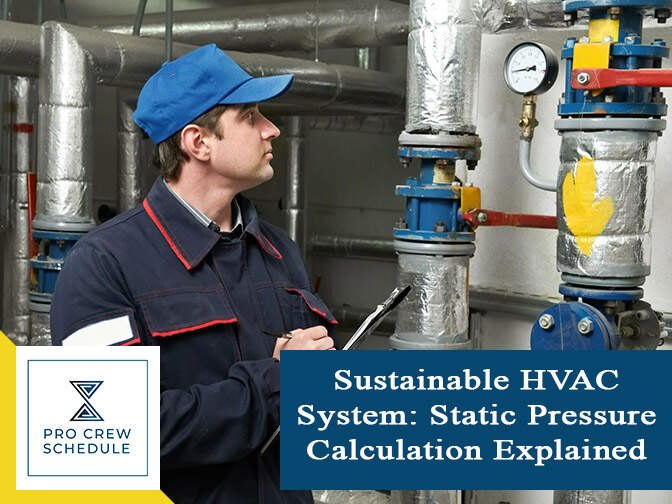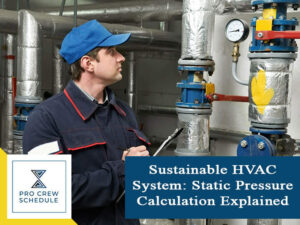For an HVAC system to function normally, equipment capabilities should necessarily match the air duct system’s many needs. To make it clear, air handling systems should be capable of overcoming the static pressure. That is why HVAC designers should focus on precise static pressure calculation for acquiring real data from which they will use to plan their next step. Other parameters included such as operating expenses, installation costs, noise, vibration and maintenance.
The static pressure calculation will be explained thoroughly for this blog, including how it became essential, how it should be measured, its diagnostics, and other related information.
What is HVAC Static Pressure?
Static pressure is generally related to duct distance, duct design, duct surface material, volumes of air and HVAC equipment obstacles. It directly describes the resistance being experienced by air as it will travel throughout the HVAC system. Hence, it is the indifferent pressure all installed fans must overcome to move the air by the ducts as it was needed for heating, cooling and ventilation. Airflow and static pressure are the two significant aspects that commonly determine the operating points of a fan as well as power consumption.
Furthermore, when static pressure tends to increase, the more costs are essentially required to overcome it. HVAC systems are purposely designed for specific cooling and heating load. Each load consists of building material, room, occupancy, design, etc. All associated elements and ductwork must be properly calculated. If the CFM is higher than usual, the added static waste energy and higher velocities can cause occupants to detect a breeze immediately. It can also cause heightened decibel levels that might become detectable throughout the system.
Numerous types of HVAC equipment can establish an airflow through ducts and the two primary examples are packaged rooftop units and air-handling units. These two pieces of equipment are typically designed to provide a specific performance for velocity and airflow. HVAC professionals not only focus on the calculation and the equipment used but also on software applications. Builder trends software is one of the most useful tools used today to help construction professionals deal and manage work.
The Measurement of Static Pressure
A manometer is a particular instrument that typically utilizes a pillar of water to measure and reflect static pressure. Air pressure elevates the water through measuring the inches. Therefore, the starting point of static pressure is still being denoted in inches of water pillars. It remains as a main unit of measurement. The particular term “manometer” is often used today about any static pressure measuring devices.
HVAC professionals also have to consider some of the most cost-effective rate changes for air velocity and friction rate. Take a look below:
· Low friction rate – is usually suggested when the electricity is costly and the ductwork installed is affordable.
· High-friction rate – is often suggested when the electricity is inexpensive or cheap and the ductwork installed is very costly.
After the first sizing procedure, the static pressure and pressure loss will be calculated separately for all duct sections. Additionally, they are often resized if it is necessary to balance the losses.
The Importance of Static Pressure Calculation
According to ASHRAE standards, HVAC professionals must calculate airflow and static pressure for a much better and sustainable design for duct systems. The designing process will be more handled efficiently by the crew involved if a task scheduler software is used. Scheduling of tasks and supervising crew will be easier and less complicated.
After all, the optimal locations for fans, air conditioning equipment and air outlets will be easily determined. Lastly, duct routes are built accordingly in terms of space availability and static pressure accuracy. Avoiding location conflicts from other building systems like plumbing and electrical installations during the design process is very imperative. Nevertheless, it can be simplified and abridged with any of the construction software applications used today. For example, a software tool like a construction scheduling software is very beneficial in project management and scheduling purposes. Work is manageable and easier using advanced software tools like this.
HVAC engineers can ultimately achieve excellent results if they are to consider the following standard rules when examining air ducts:
· Avoid unforeseen direction changes in ducts and ensure to provide turning vanes to reduce pressure drop
· Reduce ductwork losses in order to minimize the required fan horsepower
· Lessen vibration and noise since it can be disturbing for the occupants – vibration can shorten any equipment’s life span.
· As long as it is possible, the aspect ratio must be closer to 1 and no higher than 4
· For cost-effective and sustainable design, reduce the usage of space, power and materials and ensure to maximize the performance
· During the ongoing process, using a crew schedule software has proven to be very useful in terms of crew supervision and project handling
Increasing static pressure often leads to higher noise levels. Therefore, the most suggested practice is to design the air duct systems and ensure to have the lowest static pressure. Duct systems are usually being classified into three basic types. The classification is based upon their respective static pressure. Take a look below:
· Low-pressure systems – having a static pressure for up to 2 inches water gauge
· medium-pressure systems – having a static pressure for up to 2 to 6 inches water gauge
· High-pressure systems – having a static pressure for over 6 inches water gauge
Static Pressure Diagnostics
Diagnosing with static pressure is direct to the point. First, start comparing the total rated external static pressure to the full external static pressure of rated equipment. To further understand it, take a look below.
· HVAC pressure diagnostics usually have likenesses with blood pressure diagnostics. 120 over 180 is considered a good pressure by most standards.
· If the total static pressure (external) is higher than the full static pressure (rated), it indicates extreme air circulation system restrictions.
· Lower total static pressure (external) often indicates a lower fan speed or perhaps leakage inside the duct system.
· More testing might include pressure drop measurements to identify every component’s contribution for total static pressure (external) of the system. All data for pressure drop measurement can be securely saved, edited and updated using a builder software tool.
· If the static pressure is higher, it is a sign that the airflow is unusually low. Any HVAC expert has to check for any existing blockage of ducts, improper transitions, closed damps and offsets.
· Low static pressure is also a sign of trouble. Lowest pressure might indicate missing filters, leaking ductwork, separated ductwork, etc.
Air Filters Impact on Static Pressure
While many have been thinking that air filters’ primary purpose is to keep the air clean primarily, it is the other way around. Nowadays, there are already pleated filters available and have become more popular because of trapping more particles. The main issue is that the filter should also strike an optimal balance between airflow and clean air for peak equipment performance. Some pleated filters can restrict airflow, producing higher numbers on a manometer and increasing static pressure.
Dirty filters might have the same effect. However, in some few cases, most of the suggestions are to change lesser restrictive air filters instead of using more stringent and long-lasting pleated filters. Doing so, it will efficiently allow the HVAC system to breathe more and easier while maintaining the flow of clean air. Furthermore, having static pressure calculated precisely will reduce guesswork during the diagnostic process. It will only depend on the HVAC professional to determine the cause and resolutions to the occurring airflow problem.
Speaking of air filters, there are tons of speculations going on about it just because there are tons of available options. HVAC technicians must identify what the best air filter for clients is. The following are a few things to consider when choosing the best air filter for either residential or commercial spaces.
· Subjectivity – how much of filtration needed? It varies from the things listed down by the HVAC expert through his inspection. If the area doesn’t need anything heavy-duty but air quality-wise, a simple filter is enough
· Health concerns – it is one of many essential factors to consider because a few occupants tend to have allergic reactions to molds, etc. HVAC experts ensure to use filters that can trap pollen and mold spores.
· Energy Efficiency – Restrictive air filters are found to be capable of degrading the HVAC system’s efficiency. This is where HVAC professionals balance the efficient operation of the equipment used and effective filtration.
· Operational Integrity – In a few cases, restrictive air filters potentially overwork the HVAC system. It will possibly lead to premature equipment failure.
· Prioritization – HVAC professionals are very particular on using energy-efficient air filter to ensure that the system will account for the installed components
· Maintenance Simplicity – filters are often forgotten to change or replace. That is why, HVAC professionals must check and inspect the system itself for further observations.
Key Takeaways
The right answer for improving static pressure is often found outside the box (the equipment). The static pressure has always been a useful resource, for it allows HVAC professionals to see beyond the system in a new angle – where airflow becomes more visible. The main result of measuring static pressure is the capability to prescribe duct restoration work.







